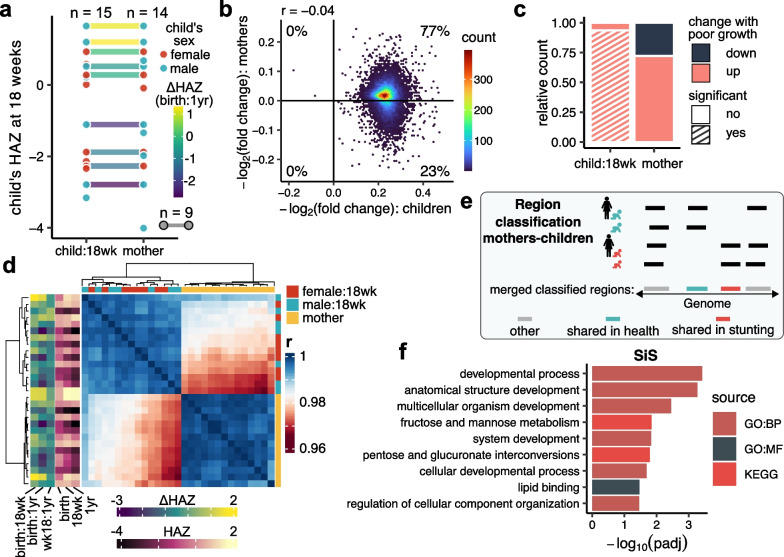Fig. 5.
Relationships between H3K9me3 profiles of mothers and 18-week-old infants. a Overview of samples used in this study. Each dot represents an individual whose sample was used in this study. X-axis separates 18-week-old children from mothers, y-axis represents child’s HAZ score at 18 weeks of age. A link is drawn only between matching mother–child pairs and is colored based on child’s ΔHAZ (birth:1yr) score. The three different ns indicate the number of 18-week-old children (left), mothers (right) and matching mother–child pairs (bottom legend). b Comparison of differential analysis results showing −log2(fold changes) per unit of child’s ΔHAZ (birth:1yr) score. On the x-axis are plotted results for 18-week-old children, on the y-axis results for mothers. Each point is an H3K9me3 region identified both in mothers and 18-week-old children. Positive values indicate increasing H3K9me3 levels in association with poor growth trajectory. The color coding shows the density of the points. The numbers indicate the percentage of points falling into a given quadrant. c Bar plot summarizing results of differential analysis from 18-week-old children vs. mothers. Regions classified as going up with poor growth trajectory are those with positive −log2(fold changes) per unit of child’s ΔHAZ (birth:1yr) score and vice versa. d Heatmap showing Pearson’s correlation coefficients between H3K9me3 profiles of all 18-week-old children and all mothers whose samples were used in this study. e Illustration showing classification of regions. Regions identified only in mothers of healthy children (green icon) and in healthy children are classified as SiH (green). Regions identified only in mothers of stunted children (red icon) and in stunted children are classified as SiS (red). f Gene set enrichment results for genes associated with SiS regions. Plotted are −log10(padj) values of significant enrichments (padj < 0.05). Results come from three different sources: KEGG, GO:MF, GO:BP

